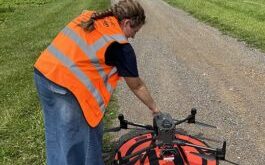The Australian Federal Police are seeking ongoing authorisation to use so-called drone-jamming capabilities that can be used to disable remotely piloted aircraft systems (RPAS) and similar unmanned aerial vehicles (UAVs).
Drone jamming devices target the frequencies used by an operator to control a drone, which generally leads to the drone either landing or returning to the point where it was launched.
The AFP has been working closely with the relevant regulator — the Australian Communications and Media Authority (ACMA) — to seek an exemption from rules governing wireless interference.
Currently there are two ACMA declarations governing jamming devices: The Radiocommunications (Prohibited Device) (RNSS Jamming Devices) Declaration 2014 and the Radiocommunications (Prohibition of PMTS Jamming Devices) Declaration 2011.
The former deals with frequencies used by satellite navigation services such as GPS (radionavigation-satellite service, or RNSS). The latter bans mobile phone jammers (a ‘PMTS’ is a public mobile telecommunications service).
Last year the ACMA issued temporary authorisation for the AFP to employ drone-jamming devices as part of providing security for the Invictus Games in Sydney.
The regulator authorised the AFP to use anti-drone measures in ‘temporary restricted areas’ declared by the Civil Aviation Safety Authority (CASA) under the Airspace Regulations 2007.
The authorisation, which expired in early November, exempted the AFP from rules that would otherwise prohibit the use of devices that could be used to disrupt drone control systems that employ the 2400-2483MHz or 5725-5850MHz bands.
The ACMA is currently considering a potential two-year exemption for the AFP that would allow the law enforcement agency to quickly deploy drone-jamming capabilities at short notice.
The exemption would apply to RNSS jammers — although the devices the AFP intends to use aren’t intended to jam RNSS frequencies, according to the ACMA they are prohibited devices because they are capable of RNSS jamming. The prohibition on PMTS jammers would remain, and the AFP would not be authorised to disrupt drone communications that used RNSS frequencies for control.
The ACMA has acknowledged that the AFP capabilities could interfere with a wide range of services, including Wi-Fi networks and bands that are designated for use by industrial, scientific and medical (ISM) applications.
“Given the ubiquity of Wi-Fi and other devices authorised by the class licence, we have considered that these are the devices that would be most likely to be affected by incidental interference caused by activation of the jamming device,” the regulator said in a document seeking input on its proposed exemption for the AFP.
“We have considered the consequences associated with those services suffering incidental interference. Although a device operated under the class licence is generally not expected to suffer interference… the ACMA has a ‘no protection’ policy regarding the class licence. Under the ACMA’s ‘no protection’ policy, devices operating under the class licence are not afforded protection from interference that may be caused by ISM applications in the ISM bands.”
The ACMA has indicated that its current view is the public benefit of being able to disrupt a drone, which would be expected to take place over a relatively short period in a confined area, outweighs the potential adverse impact.
An AFP spokesperson told Computerworld the organisation would seek to deploy counter-RPAS capabilities, including drone jamming, in a “variety of operational circumstances” — those could include “the protection of major events or places of mass gathering, programmed police operations, or in response to an incident”.
In addition to interfering with frequencies used to control UAVs, counter-drone systems can offer detection capabilities that use technologies such as radar, infrared, RF, audio and visual scanning to locate and identify drones.
The AFP spokesperson said that to “protect the integrity of its operational activities” the organisation would not comment “on operational methodologies or the full scope of its capabilities”.
“The AFP works with its national security partners to protect Australians and Australian interests from terrorism,” the spokesperson said. “The AFP is a capability led organisation and will continue to develop and utilise advanced technical capabilities to achieve its national security objectives.”
Last year Queensland Police were equipped with MkII DroneGuns, manufactured by ASX-listed company DroneShield, as part of an effort to disrupt unauthorised drone flights during the Commonwealth Games on the Gold Coast.
In December, around 1000 flights were delayed or cancelled at Gatwick Airport after drone sightings. The airport’s chief operating officer, Chris Woodroofe, recently told the BBC that it was an unprecedented “malicious” and “criminal” incident.
The Senate Rural and Regional Affairs and Transport References Committee has previously called on the government to undertake a concerted push to strengthen Australian drone regulations.
Among the recommendations of the committees’ report on the issue were that the Civil Aviation Safety Authority in cooperation with the Australian Federal Police and other relevant authorities “prohibit the use of remotely piloted aircraft systems in the airspace above significant public buildings, critical infrastructure and other vulnerable areas”.
In November, the government issued a response to the report saying it agreed in principle with that recommendation.
“CASA will continue to work with the Australian Federal Police (AFP), state and territory law enforcement authorities and other agencies of federal, state and territory governments to develop advanced processes to limit and restrict the operation of drones in certain locations,” the government said.
“The Government expects security agencies to continue to assess the threat concerning significant public buildings, critical infrastructure and other vulnerable areas and advise on any necessary restrictions utilising CASA’s existing regulatory powers.”
CASA is currently working on introducing a mandatory drone registration and accreditation scheme. The proposed system will impose registration and accreditation requirements on drones that weigh more than 250 grams and operated recreationally, and all drones operated commercially regardless of weight.
 Unmanned Aerial Vehicle The latest drone news
Unmanned Aerial Vehicle The latest drone news



